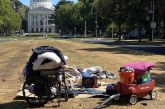
By Lauren Smith and Larkin White
Since May, Davis Vanguard has led an ongoing investigation into different county jail responses to COVID-19. In Alameda County, many currently and formerly incarcerated people have spoken out against the horrible conditions they have endured inside Santa Rita Jail.
The Vanguard recently obtained anonymous recordings from four men who were released from the jail describing their experience while incarcerated (their names have been changed for their safety and anonymity).
The testimony paints a heartbreaking picture of unsanitary housing conditions, solitary-confinement-style quarantines, rejected requests for testing, unenforced mask wearing and social distancing.
“It’s horrible in there, it really is,” says James. “It’s like a death trap… I wouldn’t want to go back in there at all.”
The interviews were conducted by Bridget Cervelli, an organizer for the California chapters of All of Us or None, a grassroots organization of formerly incarcerated advocates. She has been visiting the jail and interviewing people when they are released, as well as offering them PPE. She has posted previous interviews to: All of Us or None Soapboxx.
The concerns highlighted in these recordings are in line with previous interviews and testimonies that have come out over the last few months.
All of the recordings describe incredibly unsanitary conditions in the jail. “When I first came into the cell there were leftover lunches, bologna on the wall [and] mustard everywhere,” says Terry.
James and John describe similar experiences stating that “there are dirty dishes that they don’t wash or clean” and that “there was already trash [and] people’s food leftover.”
Despite the unsanitary and dangerous conditions, three of the men emphasized that cleaning supplies in the jail are scarce or nonexistent. “When I first got in there, they didn’t give me any cleaning supplies whatsoever,” says James.
Two others mentioned that cleaning supplies were available but they were insufficient to protect them from COVID-19. “Windex is their sanitation to clean the showers, the toilets, the mirrors,” says Troy. “That’s it. That’s all they gave us.”
Cleaning attempts are not enforced by jail staff. “Sanitation is all up to inmates,” adds John. And it is “not up to par. When you get there, there is no sanitation whatsoever.”
Their testimonies strongly contradict the ACSO’s statement that “all inmates are provided with free soap and enhanced cleaning supplies” and that “SRJ has greatly enhanced its cleaning schedule to mitigate the risks presented by COVID-19.”
The jail’s history even supports their claims. It has seen over 40 deaths in the last five years, as well as two major lawsuits in recent years over inhumane and unsanitary conditions. Two years ago, a woman sued SRJ and California Forensic Medical Group, one of two providers that merged to create Wellpath a few years ago, claiming that she was forced to give birth alone in a solitary confinement cell.
Wellpath, Santa Rita Jails’ medical provider, has its own long history of providing “substandard care.” According to a CNN investigative report, Wellpath has been “sued for more than 70 deaths” that could have been avoided if those people received proper care.
Additionally, a declaration from the May 7, 2020 filing of a new class action lawsuit details “the filth and dangerously unsanitary conditions” at the jail. The recency of the recordings obtained by the Vanguard shows that the maltreatment of those incarcerated has continued in full force.
In addition to the scarcity of cleaning supplies, and therefore a dramatically increased risk of spreading the virus, the recordings describe how jail staff rarely provide cloth face coverings to the incarcerated population as recommended by the CDC.
“Every once in a while they’d give us one mask, and that mask had to last us three months and then they didn’t change them or nothing,” says Troy. He adds that “they didn’t enforce the masks until their own deputy died. They just don’t care about us inmates at all.”
While the Sheriffs Office states that “all inmates at SRJ are provided masks and encouraged to wear a mask at all times,” case numbers from the last month support the man’s claim. Since Deputy Oscar Rocha died on July 23, only five more staff members have caught the virus, compared with 13 the month before, suggesting that the jail is taking greater precautions to protect their own members. In contrast, five incarcerated people tested positive for the virus only yesterday, while 58 people total have caught the virus in the same period.
Three men also cite a complete and total lack of social distancing. John, who was incarcerated during the major outbreak in July, states that incarcerated people are being exposed to those who have previously tested positive for COVID-19 “in the kitchen, in laundry, not to mention that they’re putting people who could’ve been in a spot that had the coronavirus in a cell with you.” His statement is supported by the reports that the outbreak had stemmed from social contact in the jail’s kitchen.
He even describes the active mixing of people who have tested positive for COVID-19 with those who have tested negative. “There are units in there [where] people have tested positive for coronavirus and when they let them out of quarantine, they’re put in units with people who already tested negative. So there’s a chance that if they don’t test them again, they could just be walking around and giving it to anybody.”
According to the CDC’s Guidance for Correctional and Detention Facilities, every jail should be implementing “social distancing strategies to increase the physical space between incarcerated/detained persons…and to minimize mixing of individuals from different housing units.” Despite having released hundreds of people in March and April, the jail appears to have disregarded this guidance in practice.
On top of the unsettling disregard for safety procedures, the recordings describe limited and opaque access to COVID-19 testing. “I’ve been tested twice, I’ve not gotten my results,” says John.
Troy recounts his testing experience before being paroled.
“If we are sick, then they wait until we are totally sick. They only give you one test. I asked for another test because I was paroling. I have a 75 year old mom and I wanted to make sure I didn’t have the coronavirus to give it to her because she has her medical problems and they denied me my test. They said that I already had one, they made up a bunch of excuses, and if I wanted to, I had to move to a whole other housing unit which was full of infected people. So, in order to go take the test I had to be exposed to [coronavirus] in order to get tested again.”
John says that if an incarcerated person does test positive for COVID-19, they are kept in a solitary-confinement-style housing unit. “It is definitely solitary confinement,” he says. “You’re in a cell by yourself, you’re coming out for thirty minutes and it’s not everyday. It’s approximately every other day if not two days.”
“If you don’t have a strong support system, you go crazy,” he adds.
On conference call last Friday, SRJ and Wellpath staff stated that those who test positive are permitted at least an hour outside their cell every day. While there is little additional evidence for either claim, the overwhelming amount of evidence corroborating the men’s other claims indicates that his statement is true.
Altogether the recordings depict a jail that is incredibly unsafe for those held inside. They build upon a number of previous interviews and testimony that have already exposed the jail for lying about conditions inside.




